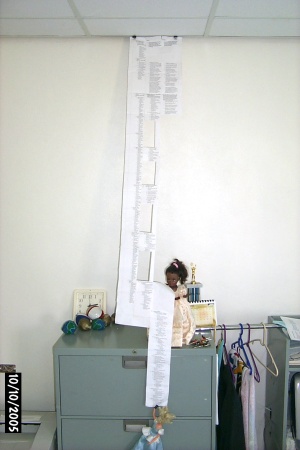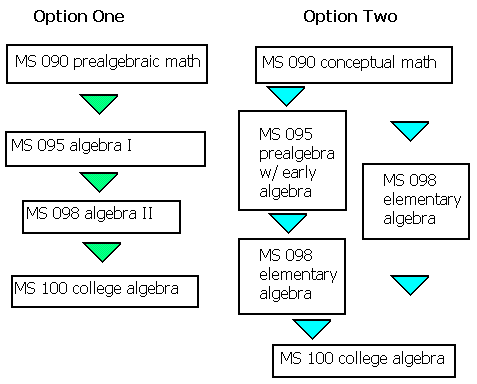Triple column developmental math outline origami
I did take the triple column print-out home and sat in my bedroom cutting and pasting like a deranged Edward Scissorhands. When I was done I had assembled six foot long scroll that made physically clear that the proposed MS 090 and the existing MS 095 outline are simply identical.
I dragged the long thing out of my bedroom and hauled it into work like some fourth grader's art project. I took it around the division showing it to anyone who would listen and probably some who did not want to listen.
Almost immediately a member of the division noted that while my origami-relative to the snow flakes we all made in elementary school might show the outlines to be similar, the texts were different and the level at which the same material is tackled in MS 095 is different from the level in MS 090. I concurred - the level might indeed be different, but then that should be reflected by the outlines. The outlines drive the curriculum and the textbook choice, if the curriculum and text differ, then the outline should be the driver and proof of that difference. This goes back to the nexus I built three years ago and the statement that "qualified faculty implementing outlines built from student learning outcomes produce trusted grades." If the outlines do not reflect what is really taught in the course, then how can we blame any campus/site for teaching the wrong material?
I hung my paper project from my curtains, where it trails down towards the floor. I wish everyone could come into my office and see this objet d'art, but in lieu of this I had a couple assistants hold it up:


Sue me - I'm a visual thinker. The tail that Barbie is hanging off of in the image on the right is the MS 098 outline. (No Barbie was harmed in the production of the above images!)
Realizing that few would probably venture into my office, especially after seeing the above images, I tried to produce something similar as a web page. The result of this effort can be seen at:
http://www.comfsm.fm/~dleeling/department/outlines/ms090_095_098synch.html
This should print out on about nine pages and should be somewhat more readable than the images above.
At the risk of jumping the gun, in my own mind (a small and scary place - see the pictures above) I can see a couple paths forward. First I should make clear my starting premises. I think Ray's content, the foundation of the proposed MS 090 outline, is right on target. The outline starts with adding and subtracting whole numbers and ends with a lightweight introduction to algebraic concepts. This is right on target for MS 090. By ending with the start of algebra the course is functionally that which comes before algebra or "prealgebra." I think John is probably right on target, the Carson text used in MS 095 is wholly appropriate to the proposed MS 090 outline.
Now hold off on jumping down my throat: I am not telling anyone to use Carson for MS 090. That is still the official text for MS 095. I am only noting that MS 090 is no longer the course that was designed for "high English-low math" conditionally admitted students ("Sashas") and has become our de facto prealgebra course based on the proposed and, I believe, fully appropriate outline.
One path forward is to model the our triplet set of developmental math courses on the American high school model: freshmen prealgebra, sophomore algebra I, junior algebra II. MS 095 would be upgraded into an algebra I course, while MS 098 might be adjusted slightly to become equivalent to algebra II. This would create a three step sequence of courses. The MS 090 outline would hold the same, and MS 095 and MS 098 would get altered. Both of these outlines are due for five-year revision in any case.
The other path forward is to, as I call it, "desequence" MS 090, returning MS 090 to its original intent of preparing "students for placement into the regular sequence of math courses offered at the College." In this scenario students are effectively "re-placed" post-MS 090 into MS 095 and MS 098. The MS 095 outline would be "tweaked" up, but maybe not as far as in the first scenario. In one variant of this idea would be to put students with an "A" in MS 090 into MS 098, Bs and Cs into MS 095, Ds and Fs back into MS 090.
The "desequencing" path would intend to put only the most deficient students into MS 090 and MS 095 would be the placement "mode" (using mode in its statistical sense) for incoming freshmen in developmental mathematics. Being a visual thinker, this is how I think of the two options:

I have to admit to being partial to option two as that is the design for MS 090 for which Stephen Blair (former chair) and I argued back in 1997. In 1997 there was no MS 090 or MS 095, only MS 050 and MS 098. In a report done in May 1997 ( http://www.comfsm.fm/comfsm/concapp.html ) I showed that the conceptual approach prepared students for MS 098. Bear in mind that MS 050 in the fall of 1996 was the same level of student as we now take into MS 090. These students continued to show signs of success into MS 100 ( http://www.comfsm.fm/comfsm/ms050098.html ), although the sample sizes fell below statistically significant numbers.
I taught a variant of my conceptual approach last spring, I hope to follow-up on those students after final grades are in for the fall term and see how they did in MS 098 versus other MS 095 students. I realize that there are many confounding factors, but it is the only downstream data available and ultimately their success rate in MS 098 is what I was trying to affect.
Note that I did NOT predict a higher rate of success for students IN the conceptual math course but rather a higher rate of success downstream.
I am open to other options. Both the MS 095 and MS 098 outlines must be revised: they have hit their five-year end-of-life cycle and must be reviewed and resubmitted to curriculum.
I would ask the state campus academic coordinators to share this note with their part-time faculty or others whom I cannot reach out to via email.
Next: Tables of contents of current texts
Dana Lee Ling wrote the following on 10/9/2005 2:36 PM:
In an effort to look at MS 090, MS 095, and MS 098, I have prepared a three-column comparison of the three courses at:
http://www.comfsm.fm/~dleeling/department/outlines/ms090_095_098.html
To print this use a landscape page set-up.
I am thinking of taking it home, taping it together, and then matching up the redundancies. Bear in mind that some redundancy is good, too much is what the president has referred to in meetings as "spoon feeding."
Dana Lee Ling wrote the following on 10/9/2005 11:57 AM:Since August I have had the MS 090 outline on my to do list as the current outline stems from 1997. I have had much trepidation in approaching this task, as the explosive mines are just below the surface of the sea and are many. I may simply call in sick this week to avoid being harangued and blasted at my desk.
I must thank Ray Verg-in for his draft of the outline, my work is actually largely verbatim lift of what he wrote, converted into the present curriculum handbook format on page eleven. I am also deeply in debt to John Saber for his most excellent syllabus. Understanding the differences and similarities in these two documents may be critical to understanding the resulting outline.
I started with a crib sheet shorthanding the two structures. Ray's structure was as follows, abbreviations by me:
A. +/- whole numbers
B. ×/÷ whole numbers
C. factors and multiples
D. fractions
E. decimals
F. ratios, proportions, percentages
G. measurements, geometry, statistics
H. intro to algebra
John had dual alpha lists at two hierarchical levels as follows (I am paraphrasing brutally here, my apologies to John up front):
upper level:
A. solve eqns
B. solve word problems
C. math symbols
D. use of a calculator
E. use of units to set up problems
lower level:
A. units and whole #s
B. eqns and whole #s
C. whole #s and word probs
D. work w/ fractions
E. fractions and eqns
F. fractions and word probs
G. decimals
H. decimals and eqns
I. decimals and word probs
J. percents
K. percents and eqns
M. percents and word probs
N. using formulas
One will note a pattern of introduction-equations-word problems that cycle through each area and structure John's course. Each area is described in detail by sub-outcomes, a link to his document is included further below for reference purposes.
Ultimately I decided that Ray's content structure was easier to "verb-ize" into student learning outcomes and maintain the parallel structure between sections of the outline. One might note that the content is now completely redundant to the student learning outcomes (hail chunk one), something I pointed out as being true for the recently approved MS 100 outline. The curriculum handbook, however, requires this redundancy, and I am simply following the policy like a good little wonk.
When I was done I realized that the MS 095 outline and the MS 090 outline have lots of overlap in terms of content. They are definitely not purely sequential. Which brings me back to the concept of re-placing students after MS 090, moving them into MS 095 or MS 098 as appropriate. For goodness sake, MS 095 is PREALGEBRA, so what is MS 090 anyway (hail chunk two)? Pre-pre-algebra? I suspect the solution is to move more algebra into MS 095 and push out the arithmetic. MS 095 should be American high school sophomore year algebra I, while MS 098 should be Algebra II. At the very least, MS 098 should move into an elementary algebra text, if it is not there already? My opinion is that we design a system that has the intention of trying to help a student move up to MS 100 in two terms, and that "three-terms to MS 100 students" should not be the primary path but rather the exception. We challenge them, accept somewhat higher rates of failure, but we push. My gut says we would probably have the president's support in this effort as he has often said we are not here to remedy the failure of the high schools to properly prepare students.
I also know that opinions differ on calculators (hail chunk three). The proposed outline includes the student learning outcome, "students will be able to borrow and carry." Personally, I do not feel this should be on the outline. I believe that if a student cannot do arithmetic by the tender age of 18 then memorization and long division are - I will be blunt here - silly. I cannot add or subtract or multiply to save my life. Every time I go to the bank I am an embarrassment. I cannot carry or borrow. And I failed math miserably in elementary and high school for these deficiencies. Once I reached college and was handed a calculator, I completed two terms of engineering calculus, advanced calculus, differential equations, complex variables, and junior year linear algebra (that's a matrix math course). I am a solid mathematician but I am dismally poor at arithmetic. So I force my students to use calculators in college. They cannot add, it is too late to memorize. I know, I know, what if they are on a desert island? Well, then they will be thirsty and need to know how to climb a coconut tree, not how to do algebra. Anyway, enough said, the new outline requires calculators. I did leave long division in the outline anyway. Call me schizophrenic. Maybe one can use the calculator to check one's long division?
As a fourth piece of hail flying through the air, I have long been keenly aware of the love/hate reaction Saxon generates. People are religiously passionate about this text. Both ways. I have one fundamental rule: we hire qualified professionals and then give them the tools they say they need to get their job done. A member of faculty said he needed Saxon, I saw to it that this happened. I could not teach from Saxon, but I understand the theory. I have my own approach and would probably wind up writing my own text to fit my concrete-to-abstract approach to conceptual mathematics. Another member of faculty said he needed an alternate text, I supported him in this. Thus the proposed outline dares to suggest alternate choices of text for MS 090 with the stipulation that we shall not order more than we need in any given term.
National site used up their second edition of Saxon, we have no texts in on shelf. So we shifted to a new text, and the outline reflects this. This is an experiment, if the new text is not appropriate we might - once the new text is exhausted - move to yet another text.
A final format note. Because the specific student learning outcomes have four outline levels and the course content has only three, there is a shift in level from the specific SLOs (lower case letters) and the content (whole numbers). The mapping, however, is one-to-one. I have noted this difficulty back in 2002. I prefer to use HTML because it is small and requires no reader. Anyone working at Chuuk, Kosrae, Yap, or FMI site knows the dread which a PDF can bring. My little Windows 98 machine in Kosrae could not even open Adobe Acrobat version 7 files - there is no version 7 reader for Win 98. And PDFs are bigger than hand-crafted pure HTML. The outline a small file for fast access in native HTML format. This assures that people are likely to actually open the file and read it. I think this is the way we should go. By the way, a final technical note, OpenOffice.org also produces very fast and clean HTML from Word documents, much smaller and cleaner than Word can accomplish, while better retaining formatting.
The proposed outline:
http://www.comfsm.fm/~dleeling/department/outlines/ms090_2005.html
The extant outline:
http://www.comfsm.fm/~dleeling/department/outlines/ms090.html
The starting points for the proposed outline:
http://www.comfsm.fm/~dleeling/department/outlines/ms090outline_vergin53.doc
http://www.comfsm.fm/~dleeling/department/outlines/ms090syllabus_saber53.doc